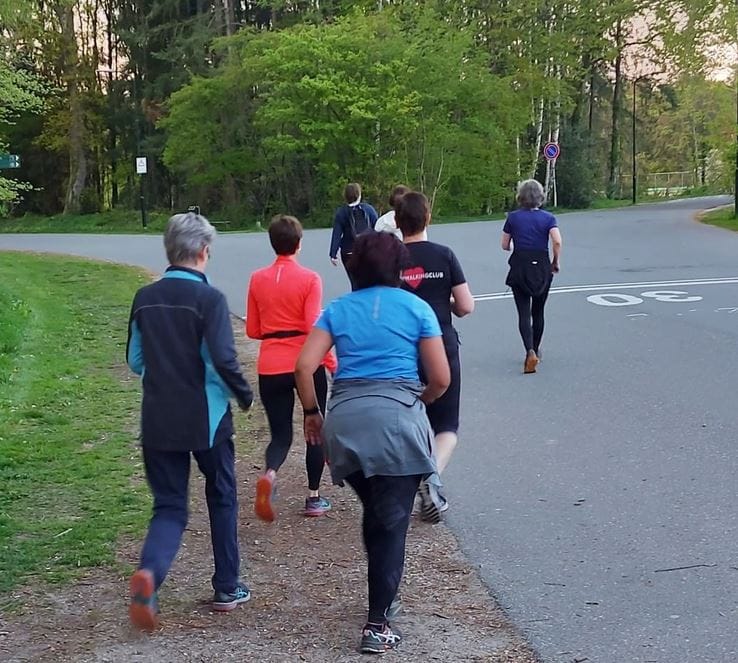Walking is often overlooked as a powerful tool for improving both physical and mental health. This article explores how incorporating walking into your daily routine can aid in weight loss, enhance mood, and promote overall well-being. By understanding effective techniques and strategies for walking, you can transform this simple activity into a sustainable exercise that fits seamlessly into your lifestyle.
Whether you are looking to lose weight, boost your mood, or simply improve your fitness level, this guide will provide actionable insights to help you maximize the benefits of walking. From mindset shifts to practical tips for integrating walking into your day, you will find valuable information to support your health journey.
In this article you will find:
The Science Behind Walking and Weight Loss
Walking is often underestimated in the fitness community, yet research shows it can play a pivotal role in weight loss and overall health. This simple, natural movement not only burns calories but also influences metabolism, mood, and physical fitness. Understanding the science behind walking can help you harness its full potential for your weight loss journey.
Caloric Burn and Metabolism
One of the primary reasons walking aids in weight loss is its ability to burn calories. On average, a person weighing 155 pounds burns approximately 140 calories per 30 minutes of brisk walking. This calorie burn can add up significantly over time, especially when combined with a balanced diet. The metabolic rate increases during physical activity, and walking helps maintain a higher metabolic rate even after the exercise is completed.
Additionally, walking can enhance your body’s ability to process fat for energy. As you walk regularly, your body adapts by becoming more efficient at utilizing fat as a fuel source, which is crucial for weight loss.
Impact on Mental Health
The benefits of walking extend beyond physical health; they also encompass mental well-being. Engaging in regular walking can reduce symptoms of anxiety and depression, and improve overall mood. This psychological boost can be a game-changer for individuals striving to lose weight. A positive mindset is essential for sustaining long-term lifestyle changes. When individuals feel good mentally, they are more likely to stick to their exercise routine and make healthier food choices.
Research has shown that even short walks can elevate mood and increase feelings of well-being. By incorporating walking into your daily routine, you can create a positive feedback loop that encourages further physical activity.
Walking as a Sustainable Exercise
Unlike high-intensity workouts, walking is a low-impact exercise that is easy to incorporate into everyday life. This makes it a sustainable option for people of all ages and fitness levels. Regular walking can be seamlessly integrated into your daily routine, whether it’s taking the stairs instead of the elevator, walking the dog, or enjoying a stroll during your lunch break.
Moreover, studies suggest that those who engage in moderate, consistent exercise like walking are more likely to maintain their weight loss compared to those who rely on sporadic, intense workouts. The key is consistency; making walking a regular habit can lead to lasting results.
Enhancing Walking for Weight Loss
To maximize the weight loss benefits of walking, consider these strategies:
- Increase Intensity: Incorporate intervals by alternating between brisk walking and a slower pace.
- Add Resistance: Use ankle weights or carry light dumbbells to increase calorie burn.
- Track Your Progress: Use a pedometer or fitness app to monitor your steps and set goals.
- Vary Your Routes: Explore different walking trails or paths to keep your routine fresh and engaging.
Incorporating these techniques into your walking routine can help you achieve your weight loss goals more effectively.
For more insights into the science of walking and its impact on weight loss, check out this research article that delves deeper into how walking influences body composition and metabolism.
Transforming Your Mindset for Effective Walking
To truly harness the benefits of walking as a form of exercise, it is essential to adopt a mindset that fosters motivation, resilience, and a positive outlook. Your mental approach can significantly impact your consistency and success in incorporating walking into your daily routine. Here, we explore effective strategies for transforming your mindset to enhance your walking experience and achieve your weight loss goals.
Embracing a Positive Perspective
A positive mindset is crucial for any fitness journey. When it comes to walking, shifting your perspective from viewing it as a chore to embracing it as a rewarding activity can make a significant difference. Consider the following:
- Focus on Enjoyment: Find pleasure in the experience of walking. Explore new routes, enjoy nature, or listen to your favorite music or podcasts while you walk.
- Set Personal Goals: Instead of comparing your progress to others, set realistic and achievable goals for yourself. Celebrate small victories, such as increasing your walking distance or frequency.
- Practice Gratitude: Cultivating gratitude for your body’s ability to move can enhance your walking experience. Acknowledge the benefits you gain from each step.
Developing a Routine
Creating a consistent walking routine is vital for maintaining motivation and making walking a habit. Here are some strategies to help you establish a routine:
- Schedule Your Walks: Treat your walking sessions as important appointments. Set specific times for your walks and stick to them.
- Start Small: If you’re new to walking, begin with short distances and gradually increase your time and intensity. This gradual approach helps build confidence and prevents burnout.
- Incorporate Walking into Daily Activities: Look for opportunities to walk throughout your day, such as taking the stairs, walking during breaks, or parking further away from your destination.
Overcoming Mental Barriers
Many individuals face mental barriers that can hinder their walking journey. Identifying and addressing these challenges is key to maintaining motivation. Common barriers include:
- Lack of Time: Reframe your thinking around time constraints. Even a 10-15 minute walk can be beneficial. Break longer walks into shorter segments throughout the day.
- Self-Doubt: Combat negative self-talk by focusing on your achievements and reminding yourself that every step counts. Surround yourself with supportive friends or join walking groups for encouragement.
- Perfectionism: Understand that not every walk has to be perfect. Embrace flexibility in your routine and allow yourself to enjoy the process rather than fixating on the end result.
Utilizing Support Systems
Engaging with others can provide additional motivation and accountability in your walking journey. Consider these options:
- Walking Buddies: Find a friend or family member to walk with. Having a walking partner can make the experience more enjoyable and encourage consistency.
- Online Communities: Join social media groups or online forums where you can share your walking experiences, challenges, and successes with others. This can provide a sense of belonging and motivation.
- Fitness Apps: Use walking or fitness tracking apps to set goals, track progress, and connect with others who share similar objectives.
Transforming your mindset is a powerful tool that can enhance your walking routine and ultimately support your weight loss journey. For more insights on the psychological aspects of weight loss, you can explore this article on motivation and behavior change.
Incorporating Walking into Your Daily Routine
Walking is one of the simplest and most effective forms of exercise, yet many people struggle to make it a regular part of their daily lives. The key to success lies in finding ways to seamlessly incorporate walking into your routine. By making walking a natural and enjoyable part of your day, you can enhance your physical fitness and support your weight loss goals. Here are some practical strategies to help you integrate walking into your daily life.
Establishing a Walking Schedule
Creating a consistent walking schedule is essential for turning walking into a habit. Consider the following tips:
- Choose Specific Times: Designate specific times for your walks, whether it’s in the morning, during lunch breaks, or in the evening. Consistency helps reinforce the habit.
- Set Reminders: Use your phone or calendar to set reminders for your walking sessions. Treat these reminders as important appointments that cannot be missed.
- Pair Walking with Other Activities: Combine walking with other daily tasks, such as walking to the grocery store, taking the dog for a walk, or walking while listening to audiobooks.

Finding Opportunities to Walk
There are countless opportunities to incorporate walking into your daily routine, often without requiring significant changes. Here are some suggestions:
- Active Commuting: If possible, walk or bike to work instead of driving. If the distance is too far, consider parking further away to increase your steps.
- Walk During Breaks: Use short breaks at work to take quick walks around the office or outside. This can refresh your mind and boost productivity.
- Opt for Stairs: Whenever you have the choice, take the stairs instead of the elevator. This simple change can significantly increase your daily activity level.
Incorporating Walking into Family Activities
Involving family members in your walking routine can make it more enjoyable and create shared experiences. Here’s how:
- Family Walks: Plan regular family walks in the evenings or on weekends. This can be a great way to bond while staying active together.
- Walking Meetings: If you work from home or have the option, hold walking meetings with colleagues. Discussing ideas while walking can spark creativity.
- Weekend Adventures: Explore local parks or nature trails as a family. Make walking a fun adventure by discovering new places together.
Making Walking Enjoyable
To maintain motivation, it’s important to make walking an enjoyable experience. Consider these ideas:
- Listen to Music or Podcasts: Create a walking playlist or listen to engaging podcasts that captivate your attention and make the time fly.
- Join a Walking Group: Find local walking groups or clubs to meet new people and stay motivated. Group walks can provide a sense of community.
- Track Your Progress: Use fitness apps or pedometers to track your steps and set goals. Seeing your progress can be a powerful motivator.
Using Technology to Your Advantage
Technology can play a crucial role in helping you incorporate walking into your routine. Here are some tools to consider:
- Fitness Trackers: Devices like Fitbits or smartwatches can help you monitor your steps, calories burned, and overall activity levels.
- Walking Apps: There are numerous apps available that can help you plan walking routes, track distances, and connect with other walkers.
- Social Media Challenges: Engage in walking challenges on social media platforms to create accountability and camaraderie with friends and followers.
 Incorporating walking into your daily routine doesn’t have to be a chore. By strategically finding opportunities to walk and making it enjoyable, you can significantly enhance your physical activity levels and support your weight loss journey. For additional resources on walking and fitness, visit the CDC’s Physical Activity Guidelines, which provide valuable insights and recommendations for staying active.
Incorporating walking into your daily routine doesn’t have to be a chore. By strategically finding opportunities to walk and making it enjoyable, you can significantly enhance your physical activity levels and support your weight loss journey. For additional resources on walking and fitness, visit the CDC’s Physical Activity Guidelines, which provide valuable insights and recommendations for staying active.
Maximizing Health Benefits Through Walking Techniques
Walking is not just a simple form of exercise; it is a versatile activity that can be tailored to meet individual health goals. By employing specific walking techniques, you can enhance the benefits of your walks, making them more effective for weight loss, cardiovascular health, and overall well-being. Here, we explore various strategies to maximize the health benefits you can derive from walking.
Posture and Form
Maintaining proper posture and walking form is essential for preventing injuries and optimizing the effectiveness of your workout. Focus on the following:
- Stand Tall: Keep your head up, shoulders back, and spine straight. This alignment helps reduce strain on your back and neck.
- Engage Your Core: Activating your core muscles provides stability and balance, allowing for a more efficient walking motion.
- Foot Placement: Land on your heel and roll through to your toes as you push off. This technique promotes a natural gait and reduces impact.
Incorporating Interval Walking
Interval walking involves alternating between periods of high-intensity walking and lower-intensity recovery. This method can significantly boost your cardiovascular fitness and calorie burn:
- High-Intensity Intervals: Walk at a brisk pace for 1-2 minutes, then slow down for 1 minute to recover. Repeat this cycle for the duration of your walk.
- Hill Walking: Incorporate inclines into your walking routine. Walking uphill increases the intensity and engages more muscle groups.
- Timed Intervals: Use a timer or a walking app to keep track of your intervals, ensuring you maintain the correct intensity levels.
 Adding Resistance
Adding Resistance
Using resistance can enhance the effectiveness of your walking workouts. Here are several options:
- Weighted Vests: Wearing a weighted vest can increase the intensity of your walk, promoting greater calorie burn and muscle engagement.
- Walking Poles: Incorporating poles engages your upper body while walking, providing a full-body workout that can improve cardiovascular health.
- Ankle Weights: While walking, wearing light ankle weights can increase resistance, helping to build strength and endurance.
Mindful Walking Techniques
Mindfulness can enhance the walking experience and improve mental well-being. Consider these techniques:
- Focus on Your Breathing: Pay attention to your breath as you walk. Deep, rhythmic breathing can enhance relaxation and improve oxygen flow.
- Be Present: Engage your senses by noticing the sights, sounds, and smells around you. This practice can reduce stress and enhance enjoyment.
- Walking Meditation: Combine walking with meditation techniques, focusing on each step and the rhythm of your movements to cultivate mindfulness.
Tracking Your Progress
Monitoring your walking activity can motivate you and help you stay on track with your health goals. Here are some effective methods:
- Use Fitness Apps: Many apps allow you to track your steps, distance, and calories burned. Popular options include MyFitnessPal and Strava.
- Wear a Pedometer: A simple pedometer can help you set daily step goals and monitor your progress toward achieving them.
- Keep a Walking Journal: Documenting your walking experiences, including distance, time, and feelings, can provide insights into your progress and motivate you to continue.
Incorporating Variety
To prevent boredom and keep your walking routine engaging, try incorporating variety into your walks:
- Change Locations: Explore different walking trails, parks, or neighborhoods to keep your walks interesting.
- Try Different Paces: Experiment with slow, leisurely walks versus brisk walks to see how each affects your mood and energy levels.
- Join Group Walks: Participating in walking clubs or community events can provide new challenges and a sense of camaraderie.
By implementing these techniques, you can maximize the health benefits of your walking routine and turn this simple activity into a powerful tool for fitness and well-being. For more insights on enhancing your walking techniques, visit this ACE Fitness article that offers additional tips and guidance.
Walking is a powerful and versatile exercise that can significantly aid in weight loss and improve overall health. To maximize its benefits, focus on maintaining proper posture and form, such as standing tall and engaging your core. Incorporating techniques like interval walking, adding resistance with weights, and practicing mindfulness can enhance the effectiveness of your walks. Regularly tracking your progress with fitness apps or journals can also keep you motivated and accountable.
To successfully integrate walking into your daily routine, establish a consistent schedule, find opportunities to walk during your day, and make the activity enjoyable by listening to music or joining walking groups. Embrace a positive mindset by setting personal goals and celebrating small achievements. By combining these strategies, you can create a sustainable walking habit that supports your fitness and weight loss journey.


 Adding Resistance
Adding Resistance

